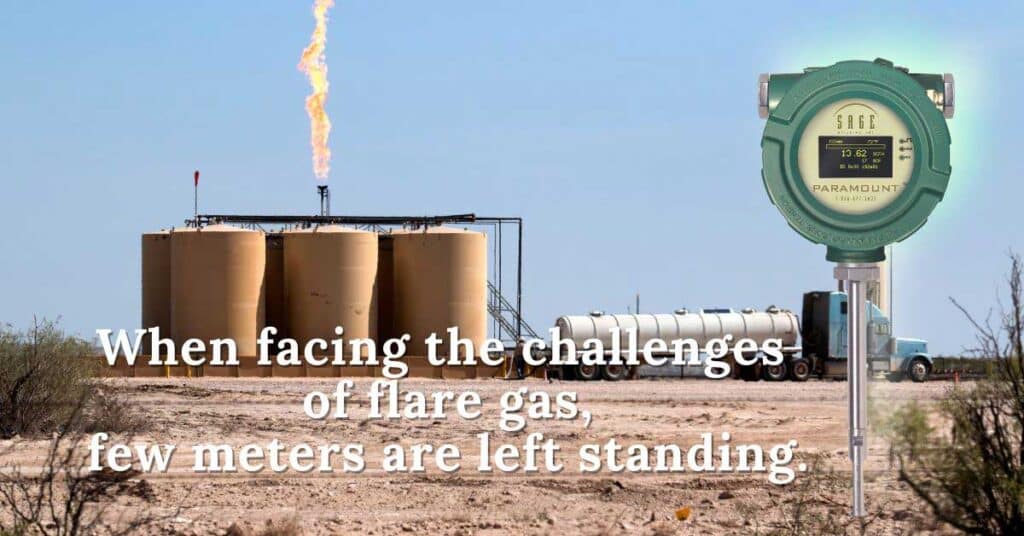Recently, the EPA announced a final rule impacting the oil and gas industry to decrease its methane emissions and volatile organic compounds (VOC).
With the new stringent regulations, petrochemical engineers will be responsible for complying with the final rule, requiring technology such as Sage thermal mass flow meters to monitor the related emissions. Thermal mass flow meters excel in this area: methane leak detection, flare gas emission, and GHG emissions. The Sage Paramount provides extreme sensitivity to low flow rates and the wide turndown needed for flaring upset conditions. Additionally, the meter features explosion-proof approvals (CL I Div 1) for demanding flare gas applications.
Here is a preliminary look at the EPA methane rule for the oil and gas industry.
EPA Final Rule on Methane Emissions Reduction
On December 2, the EPA announced a final rule impacting the oil and natural gas industry. The rule targets methane emissions and other air pollutants, including VOCs. In this rule, the EPA enacted new source performance standards (NSPS) for methane and VOCs from new or modified oil and gas sources and emissions guidelines for states to design and execute implementation plans for existing sources.
The EPA also included measures to decrease flaring and fugitive emissions from oil and gas production operations. It also moved forward with the EPA “Super Emitter” program, permitting third parties to track significant emissions events. However, the final rule includes supplementary flexibility for industry and states compared to EPA’s earlier proposals. This flexibility permits more time for states to submit their plans to comply at existing facilities, additional time for specific requirements, and flexibility for the industry to use advanced monitoring technologies to detect methane leaks.
Oil and Gas Facilities Impacted
The final rule applies to the following new and existing oil and gas operations:
-
- Production and processing, together with equipment and processes at gathering and boosting compressor stations, well sites, storage tank batteries, and natural gas processing plants
- Natural gas transmission and storage, inclusive of storage tank batteries and compressor stations
5 Key Outcomes of the Methane Emissions Rule
The following are five noteworthy takeaways from the December 2 final rule:
-
- The new rule requires frequent monitoring and repairing methane leaks at compressor stations, well sites, centralized production facilities, and using established inspection technologies or new advanced detection technologies at an operator’s choice.
- Storage vessels at production facilities are regulated in essentially the same manner under this final rule as existing VOC stipulations. However, storage vessels previously unaffected by the rule, including new and existing facilities, may now be subject to NSPS based on updated definitions and adding a new applicability trigger.
- The rule aims to phase out the venting and flaring of oil wells’ gas. According to the EPA, the most significant emissions reductions created by the final rule come from eliminating routine gas flaring and requiring continuous operation of flares on storage tanks.
- The EPA’s creation of the “Super Emitter” program to identify and address significant methane leaks from production facilities is unique to this rule. The program offers an avenue for qualified third parties to alert the EPA of owners and operators exceeding the emissions standards and for the EPA to require owners/operators to investigate the alerts.
- The rule imposes new requirements on reciprocating compressors, pneumatic pumps, centrifugal compressors, controllers (even prohibiting the use of natural gas in all but a few circumstances), sweetening units, and the completion process and liquids unloading process.
What does Quad O, Ob, and Oc have to do with it?
The new rule establishes a role for both federal and state standards.
-
- The new federal NSPS added at 40 C.F.R. part 60, subpart OOOOb (Quad Ob), applies to sources that began construction, modification, or reconstruction after December 6, 2022.
- Existing sources will be regulated by emissions guidelines enacted in state programs equivalent to federal NSPS. These emissions standards (serving as model rules for states to implement) are outlined in a new subpart, OOOOc (Quad Oc). States can either adopt presumptive standards outlined in Quad Oc for existing sources or develop specifications that are as strict as the federal standards, and they must conduct meaningful public engagement while setting these requirements.
- The EPA must approve all state emissions standards, and if a state’s standards are not as strict as the federal standards, the EPA can then promulgate a rule for that state.
What is the date of applicability?
-
- The final rule’s “applicability date” is December 6, 2022. Sources constructed, modified, or reconstructed after December 6, 2022, must comply with the new source performance standards in Quad Ob.
- Sources constructed before December 6, 2022, will be considered existing sources and have later compliance dates under state plans. For existing sources, states have two years to propose these standards, and operators have three years after that submission deadline to comply. Therefore, the existing sources’ compliance deadline will vary based on location but could be up to five years.
More information will come on the EPA’s Methane Reduction program and how the Sage thermal mass flow meters can assist industry operations in complying with the new stringent protocols.
Source for the EPA update information:
Stacie Fletcher, Rachel Levick, Veronica J.T. Goodson, Monica Murphy, Samantha Yi, Dominic Solari, “EPA Issues Methane Rule for Oil and Gas Sector,” December 5, 2023, https://www.gibsondunn.com/epa-issues-methane-rule-for-oil-and-gas-sector-practical-takeaways-for-industry/


